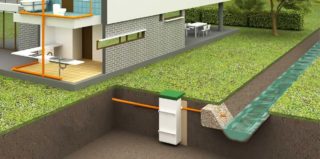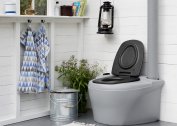Often, to ensure comfort, special conditions are required that the central sewage system is not able to provide. It is for this that they often mount an autonomous version of it, but how to install it correctly so that there are no troubles in the future?
What is autonomous sewage
 Autonomous sewage is a building of local character, which performs the function of wastewater treatment and is a worthy alternative to the central sewage system. Wastewater treatment methods in such a sewer are divided into three types: biological, mechanical and chemical. The first method is carried out using microorganisms that extract organic matter from drains. The mechanical method consists in removing insoluble impurities from water under physical or mechanical stress. As for the chemical way of purification, there is an active use of coagulants, the interaction with which contributes to the purification of water.
Autonomous sewage is a building of local character, which performs the function of wastewater treatment and is a worthy alternative to the central sewage system. Wastewater treatment methods in such a sewer are divided into three types: biological, mechanical and chemical. The first method is carried out using microorganisms that extract organic matter from drains. The mechanical method consists in removing insoluble impurities from water under physical or mechanical stress. As for the chemical way of purification, there is an active use of coagulants, the interaction with which contributes to the purification of water.
The autonomous sewage system itself consists of:
- Internal sewerage networks (pipelines and water intake inside the house);
- External sewage networks (pipes leading from the house to the septic tanks, always with a slope, so that the water moves by gravity);
- Sewage treatment plant;
- Filtration fields.
The principle of operation of most autonomous sewers is the phased treatment of wastewater in several chambers. The septic tanks in which this is carried out can be divided into underground filtration plants and small biological treatment plants.
- The first ones include the septic tank itself, where sewage from the house gets and where it is defended and partially fermented in an anaerobic environment, and an underground filtration system where the clarified water is cleaned by passing through a sand-gravel filter or a special filtering trench.
- Each of the structures of the second type consists of several chambers, which are united in a building. First, the water is cleaned in a septic chamber, then, freed from large particles, it enters the aeration tank, where the aeration capacity of the biofilm is used for deep cleaning.
Advantages and disadvantages of the system
M the inuses of autonomous sewage directly depend on its type, since they can be conditionally divided into volatile and non-volatile.
the inuses of autonomous sewage directly depend on its type, since they can be conditionally divided into volatile and non-volatile.
Volatile systems operate due to aerobic bacteria that need access to air, which is why a special compressor is used in such facilities, and it consumes electricity. Regarding the consumed electricity, it is not more than 70 W / h. In the case of them, their high cost can be distinguished from the shortcomings, since there are much more pluses:
- Complete processing of effluents into usable water;
- Discharge of water to an arbitrary place;
- Absolute tightness;
- In some cases, there is absolutely no need for the services of scavengers;
- Compactness;
- Fast cleaning processes.
Non-volatile are containers made of brick or plastic, which are divided into several septic tanks, passing through which water is clarified by about 50 percent. The remaining cleaning is carried out in the filtration fields. If we talk about such installations, then everything is exactly the opposite. Of the advantages, one can name only the cheapness and ease of installation. While there are many more flaws in such systems:
- A large amount of earthwork;
- Allocation of a large area under the filtration field;
- Permanent pumping of runoff and payment of regular services of sewage collectors;
- Sooner or later, sewage will begin to penetrate the ground, poisoning it in this way;
- Persistent unpleasant odor that is difficult to eliminate.
Despite all these shortcomings, the second type of autonomous sewage system is much more popular than its more expensive version. But if you calculate the cost of servicing non-volatile systems, you will notice that the amounts become approximately equal.
Installation Manual for Autonomous Sewerage
 Before starting work, it is worthwhile to carefully analyze the following factors of your site to ensure the most successful construction. So, the key role is played by:
Before starting work, it is worthwhile to carefully analyze the following factors of your site to ensure the most successful construction. So, the key role is played by:
- The relief of the site;
- Climate;
- Soil and its components;
- Groundwater location and level;
- The number of residents of the house and the term of residence in it;
- The presence of obstacles that impede the entry of sewage trucks.
It is not worth it to carry out work and calculations alone, because in case of the slightest mistake you risk throwing money away and making problems in the form of inefficient sewage or its constant need for repair and additional maintenance.
In order for the station to work successfully, be guided by the following rules:
- A place in loose and non-acidic soil is suitable for draining sewage, because suitable microorganisms live there, also make sure that this place is at a fairly large distance from the house and other buildings. Do not forget that it should be at the maximum distance from the well, if any;
- Before installing sewer pipes, make sure that the drawings correctly indicate the level of groundwater and the depth of freezing.
- The cesspool must be equipped with concrete rings or bricks to ensure reliable sealing;
- Invite specialists to install pipes, at this point it is not worth saving, since with their poor installation there is a chance to nullify the entire sewer system.
Next, you should calculate the estimated number of drains, leaving the number of permanent residents. This is approximately 200 l / day per person.
This is followed by the arrangement of the pit, in which the septic tank will be located in the future. Pipes will be connected to it, through which sewage will move. Remember that it is worth laying out so as to minimize the number of turns, because they are the first reason for clogging the pipeline, they should also be laid on compacted sand, due to the fact that any soil begins to sag over time.
If you want to avoid freezing of the external pipeline, take care of its high-quality insulation, or equip the building with heating. In order to eliminate the possibility of freezing of the outer pipes, lay a cable that will be connected to electricity and will provide the desired temperature even in the most severe frost.
Also remember that such places are a frequent refuge for rodents, so leaving a sufficient amount of poison there will also not be superfluous.
Installation of an internal sewage system also carries several subtleties:
- The most popular pipes for domestic sewage are PVC or PP pipes;
- The standard slope for laying is 1-3 centimeters per linear meter. At the junction of pipes, a bell-shaped connection is used, if necessary, this can be a tee or revision;
- Fixing the pipe to the wall should be strong and carried out on special clamps;
- Installation and connection of plumbing in the house should be thought out to avoid unnecessary work and pipes. Best place the toilet near the sewer riser.


